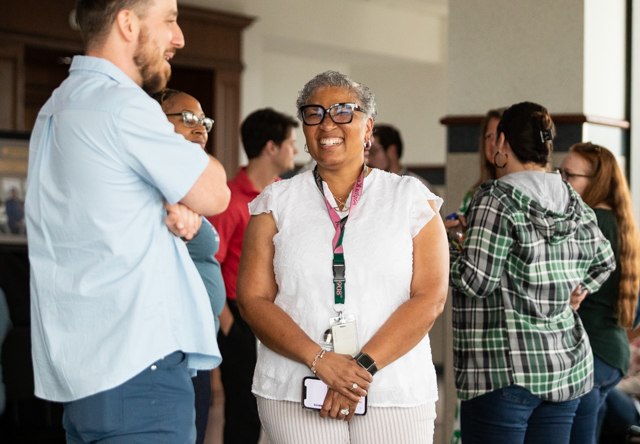PROGRESS: Western: An institution of opportunity, in progress
Published 6:00 am Friday, March 28, 2025
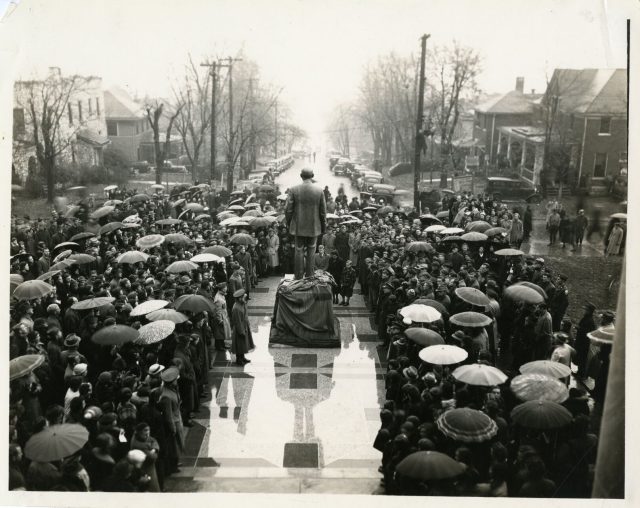
- The dedication of the Henry Hardin Cherry statue is held outside Cherry Hall on Nov. 16, 1937. (Photo courtesy of WKU Special Collections Library.)
DAVID MAMARIL HOROWITZ
david.horowitz@bgdailynews.com
Cherry Hall, three stories tall and 105,268 square feet, casts an afternoon shadow before its facade. Trees on either side of the hall’s front yard see their branches sway in a light breeze. Traffic ebbs and flows between College Street and College Heights Boulevard.
Trending
Front and center from the hall, a bronze statue of Henry Hardin Cherry overlooks northeast Bowling Green, a cluster of buildings amid roads that jut through Kentucky’s fastest-growing city.
A Westminster-style chime resonates throughout campus. More than 90 buildings, according to the campus map, serve this community. Nearly 2,800 administrative staff oversee it. Some 900 instructors teach. In fall, enrollment was more than 16,000.
Let’s rewind to the turn of the 20th century.
The hilltop was known as Vinegar Hill: a rugged, overgrown area of rocks and cedar trees; a Civil War fort started by Confederates and finished by members of the Union; a school for women known as Potter College for Young Ladies; the nearby Ogden College, for collegiate and preparatory courses; also close by, a predominantly Black neighborhood known as Jonesville.
Western Kentucky University’s transformation has been an intentional effort spanning more than a century.

A print displays a bird’s-eye view of Bowling Green from the Potter College for Young Ladies in 1894. (Photo courtesy of WKU Special Collections Library.)
This history was detailed by Lowell Harrison in “Western Kentucky University.” Any attempt to encompass it in any 4,000-word article is an exercise in selection. Still, there are events of undeniable impact – the frontrunners, and a reporter’s choice of change.
Trending
The university – whose history was presided over largely by a handful of long-term presidents – can be recalled in epochs.
WKU President Timothy Caboni, former president Gary Ransdell and former WKU historian David Lee shared how they perceive these eras. Their accounts largely align with few differences – epochs further corroborated by WKU archivist Suellyn Lanthrop.
Henry Hardin Cherry laid a foundation for a state normal school built upon by Paul Garrett. (Lee, the historian, added that he considers Cherry to have his own epoch.)
Kelly Thompson transformed it into a fully fledged university through promotion and construction, spurring growth and change that Dero Downing navigated.
A period of rapid presidential turnover, beginning with John D. Minton, concluded with stability brought forth by Thomas Meredith.
Ransdell, over 20 years, completed a host of projects that brought the university to new heights.
And Caboni himself, approaching his eighth year, focuses on academic quality and retention – building his own vision for what Western can become next.
Asked what WKU and its history has represented, Lee recalled Cherry’s aim.
“I think Henry Hardin Cherry created this institution to be an institution of opportunity, and on our best days, I think that’s what we’ve been,” Lee said. “It’s taken us a while to learn that there were some students that we were not an institution of opportunity for – like Black students or students who use wheelchairs (…).
And it’s a process that’s continuing. I think we were created to be an institution of opportunity, and we have over 100 years learned more and more about what that means, and to try to fulfill that goal – that dream.”
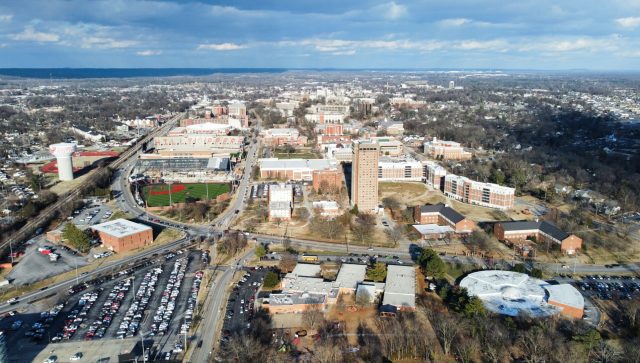
The campus of Western Kentucky University as of January 2025. (Grace McDowell.)
A vision in post-war BG
A system of public education began to develop in Kentucky for much of the late 19th century – but there was a shortage of teachers.
This, Lee said, created a demand for “normal” schools to prepare people to become teachers.
Seeds for what would become Western Kentucky State Normal School – and decades later, WKU – were planted by two farmers: Cherry and his older brother, T.C. Cherry. Each worked on their father’s farm till age 21, Harrison writes, and what they earned in their last six months, they could keep.
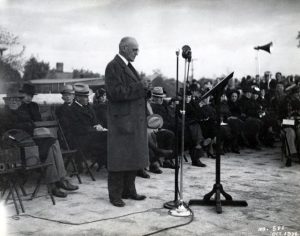
Western’s first president, Henry Hardin Cherry, speaks at a microphone in October 1936 as the cornerstone is laid for the building that – about a year later, following his death – becomes dedicated to him and named Cherry Hall. (Photo courtesy of WKU Archives.)
Henry Hardin Cherry knew he wanted to pursue an education, Harrison writes.
Each did so: T.C. Cherry moved to Glasgow, and Henry Hardin Cherry – with $72 from cutting hickory trees for axe handles – entered the Southern Normal school, according to Harrison.
Following the Southern Normal school president’s departure, Henry Hardin Cherry convinced his brother to return to the area and invest $1,600, according to Harrison. Together, they opened the Bowling Green Business College and Literary Institute in 1892, Harrison writes, and two years later, they added the Southern Normal School.
Their path was anything but straightforward: Among a myriad of other challenges, fire consumed the normal school. Henry Hardin Cherry and the school faced bankruptcy. Still, the brothers built one of the nation’s largest private schools, according to Harrison.

The Southern Norman School student body in an undated photo. (Photo courtesy of WKU Archives.)
In 1906, Cherry spent 71 days in Frankfort lobbying for creation of a state normal school, Harrison writes – and shortly after, the General Assembly approved it, and Bowling Green and Richmond were picked as the locations for Kentucky’s first two.
Western Kentucky State Normal School opened in 1907.
The school had no salary scale, written contracts or faculty ranks, according to Harrison. In 1907, four students out of more than 700 had high school diplomas, he writes.
Teaching loads, Harrison adds, were 25 to 30 hours a week. A faculty member recalled class sizes “‘were limited only by the chairs a room could possibly contain, plus and including the number of windowsills available as seats,’” Harrison writes.
Still, since the years of the private Southern Normal, Henry Hardin Cherry was known to have laid a foundation of values and ambition for the institution, Lee said.
One 1893 enrollee, according to Harrison, stated that the school “reached its highest marks in creating inspiration. The loyalty of the teachers and the students never ran low. They thought of the institution as their own. It was their first love. They gloried in its growth.”
“Henry Harden Cherry obviously had a unique and spiritual role in not only our founding, but in our early growth as an institution,” Ransdell said.
From the days of the private Southern Normal, Henry Hardin Cherry was known for his daily chapel service. Many featured the president’s stories and exhortations for students as he imparted lessons and morals, Harrison writes – among them, what would become the university motto: “The spirit makes the master.”

Western’s first president, Henry Hardin Cherry, addresses students in at the chapel within Van Meter Hall sometime between 1934 and 1937. (Photo courtesy of WKU Archives.)
He was known as a relentless promoter, too, and when the facility couldn’t keep up with enrollment, one thing became clear: “Cherry’s vision for the future greatly exceeded the limits of the College Street site,” as Harrison said.
The school purchased 162 acres starting at the crest atop Vinegar Hill in 1909, according to Harrison – a decision so unpopular, the president said he stayed off city streets for a couple months due to the number of bad encounters, Lee said.
They acquired two buildings from the Potter College for Young Ladies, which had gone bankrupt, and later merged Ogden College, Lee said. Van Meter, which would house offices and the chapel, had also become the school’s first large facility built atop the hill.
“Not only do you get the foundations to what the institution is now, but particularly in the ’20s – so much of the physical plant around the top of the hill that’s still in use (was) put in place,” Lee said.
Enrollment increased from 1,024 in the 1907-1908 academic year to 2,616 in 1921-22, according to Harrison.
In 1922, the school became the Western Kentucky State Normal School and Teachers College.
WKU’s first president died in 1937.
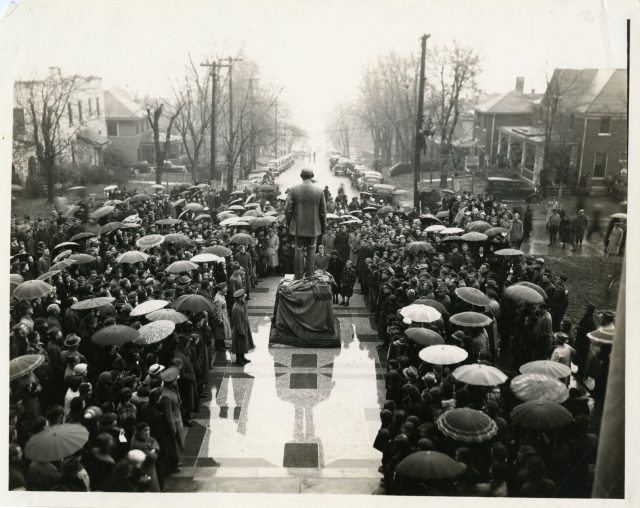
The dedication of the Henry Hardin Cherry statue is held outside Cherry Hall on Nov. 16, 1937. (Photo courtesy of WKU Special Collections Library.)
“That oneness as a university family — as a pride, and (…) the spirit, and the determination, and his propensity to be all in and inspire our students to think in ways — probably (…) stretched their abilities and widened their view of both themselves and Bowling Green, Kentucky and beyond,” Ransdell said. “He just was a motivator, and one who inspired people in rare and strong ways.”
In comparison, Harrison describes Garrett’s presidency as an interlude. Not a lot of dramatic change took place under his presidency, Lee said.
“Paul Garrett was a classic administrator, and a little more soft spoken (…) but very able to not only sustain but build on Dr. Cherry’s dreams,” Ransdell said.
Caboni referred to Garrett as a caretaker who continued to advance his predecessor’s vision.
Garrett dealt with a difficult time for the university during World War II, as many men went to fight overseas, creating enrollment challenges, Caboni said. The second Western president also navigated the return of soldiers and oversaw the creation of Veterans Village down the hill following the war, an area composed of 214 dwellings, according to the WKU archive.
“Dr. Cherry and to lesser extent, Paul Garrett, (…) helped create, in my opinion, an identity for the institution that has sustained to this day a spirit – a uniqueness, if you will – from our geography on the Hill to things that really defined our character as an institution,” Ransdell said.
Parallel to the development and popularity of Western, one figure in particular had, over the decades, acquired national renown – a fame to be further bolstered by a president who oversaw promotion and construction that would transform the university.
On the Map
Forty-two seasons. One-thousand-and-sixty-one games. A winning percentage of nearly 72%. And character.
Edgar Allen Diddle coached basketball at WKU from 1922 to 1964 and brought the university national recognition. Ransdell described him as a showman – and a standout example of how WKU’s third president, Kelly Thompson, marketed the university.

Renowned Western basketball coach Edgar Allen Diddle talks to Odie Spears, E.A. Diddle, Dee Gibson, Don Ray, John Oldham and Oran McKinney sometime between 1947 and 1948. (Photo courtesy of WKU Archives.)
Thompson knew, for instance, that WKU athletics’ iconic red towel would begin to define the university’s brand, Ransdell said. The third president took advantage of emerging media such as television and radio – for example, changing WKU’s colors from red and gray to red and white under the belief it would look better on TV. Thompson made Diddle more than a basketball coach – “on a national scale, and that had implications for the university that went well beyond the basketball court,” Ransdell said.
“ … Thompson knew that Ed Diddle gave the university the opportunity to have a unique story, to have a unique style, do things a little bit different,” Ransdell said. “ … (Thompson) was a classic – and I say this in a positive way – a classic public relations guy. He knew how to communicate with the public. He knew how to market Dr. Cherry’s spirit.”
Simultaneously, his presidency marked a dramatic transformation in the university’s history. He presided over some 40 major construction projects, Lee said – and enrollment, Lee added, skyrocketed from about 2,000 students to 11,000 in a decade.
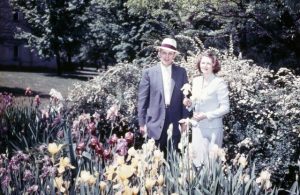
Kelly Thompson, Western’s president from 1955-1969, stands beside his wife, Sarah Thompson, in 1965. (Photo courtesy of WKU Archives.)
Finally, in 1966, the once-state college became Western Kentucky University.
Thompson stepped down in 1969 and died in 1993.
Ransdell recalled a couple times he returned to town after driving with Thompson. Rather than be dropped off, Ransdell said, Thompson would tell him, “ ‘No, no, no – I want to ride around campus just one more time.’ He was serious. He wanted to just slowly take your time.
‘Let’s just ride around campus one more time.’ ”
Race relations and razing
The 1904-enacted Day Law restricted African-Americans from attending the same schools as white students. A Japanese student attended during WW II, Lee said, but Black students remained banned.
After some 50 years, that started to change.
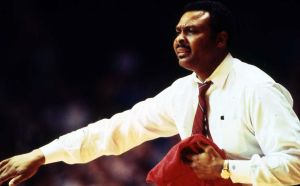
WKU men’s basketball head coach Clem Smith Haskins holds a red towel sometime between 1985 and 1986. Haskins and Dwight Smith in 1963 had become the first two Black scholarship athletes in Western’s basketball program. (Photo courtesy of WKU Archives.)
The Supreme Court decision in Brown v. Board of Education outlawed segregation in education in 1956. Two years later, WKU enrolled its first Black students. In 1963, Clem Smith Haskins and Dwight Smith became the first Black scholarship athletes recruited by WKU to join the basketball program. In the ’60s, WKU hired its first faculty and professional staff who were African-American, Lee said.
And then, Jonesville – a 34.7-acre, predominantly Black neighborhood – was razed so Western could expand.
“I never set foot in Jonesville because it was destroyed in the decades before I was born,” Akisha Townsend Eaton – whose mother Angela Townsend was born where Diddle Arena now stands – told the Daily News last year. “But it’s very much alive in the stories that have been passed down and the records that we’ve kept.”
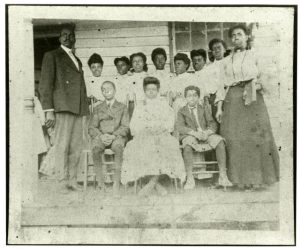
Jonesville school students pose for a picture around 1900. (Photo courtesy of WKU Special Collections Library.)
It was well known by community members to be tight-knit and self-sufficient, with businesses such as beauty salons, barber shops and drug stores.
Longtime organizer and artist Alice Gatewood Waddell, who would visit the neighborhood as a child, previously recalled to the Daily News remembering mostly the family gatherings.
“The community was almost like a big family – a welcoming community, and people knew each other very closely,” Gatewood Waddell told the Daily News last year.
Western faced opposition from property owners when attempting to expand in the ’50s. In response, the WKU Board of Regents authorized condemnation proceedings amid the urban renewal movement, which was destroying Black neighborhoods across the states – enabling WKU to purchase properties for reportedly far less than market value.
“I think the university was, to pick a word, heedless in the way it dealt with Jonesville and seemed to take little account of what the destruction of Jonesville meant for the lives of the 400 or so people who lived there,” Lee said. “And I think it’s significant that it’s taken us a long time to really make what happened there a part of our story as an institution, part of the story that we tell to ourselves and we tell to others about who we are as a university.”
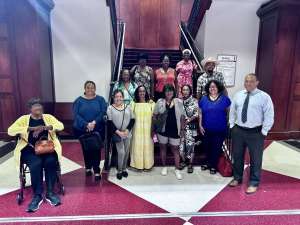
Thirteen descendants of Jonesville reunite for an informal gathering in 2024 at WKU where they heard updates from the university’s Jonesville Reconciliation Workgroup as well as discussed plans and ideas for the future. (SUBMITTED.)
WKU has made progress on that front under Caboni’s presidency.
He established the Jonesville Reconciliation Workgroup in the spring 2022 semester, an action made possible by the Naming and Symbols Task Force he formed two years prior. Its primary purpose, according to Western’s website, is to “assess the best way(s) to appropriately address the issues that remain from the dismantling of the Jonesville neighborhood.”
The administration initially charged the workgroup with two aims, which are its current focuses: adding “honorific naming of spaces on campus after Jonesville” and hosting “an annual reunion/conference for Jonesville residents/descendants and WKU community.”
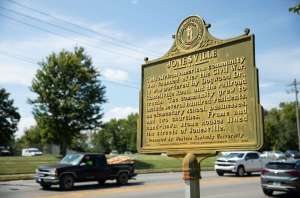
An historical marker sharing a brief history of the former Jonesville African-American community before it was destroyed for the expansion of Western Kentucky University’s campus stands on the corner of Avenue of Champions and University Blvd. (Grace Ramey McDowell/grace.mcdowell@bgdailynews.com)
Its first project two years ago became the Kentucky Museum exhibit “Honoring Jonesville: Our People, Our Community, Our Legacy,” which featured oral histories from residents and descendants.
“I think (Jonesville’s razing) also created a breach between the institution and the Black community in Bowling Green that is still taking a while to heal,” Lee said. “So, I think it’s a significant moment, both in terms of when it happened, but also in terms of the institution, over decades, slowly beginning to come to terms with what happened there.”
Downing, and a search for direction
Western’s transformation into a university begged the question of what would come next.
“I tend to see the period maybe after President Thompson as a kind of a long stretch for the institution really trying to define what it means to be a university,” Lee said. “I think a lot of the next several years, a few decades, was more transition in terms of presidential leadership. There’s a kind of casting around for what’s our direction going forward.”
Downing, the first president to take this on after Thompson, continued to advance the latter’s growth through 1979.
He was tasked with completing numerous campus construction projects Thompson had started and dealing with the aftermath of the explosive enrollment growth from his predecessor’s tenure. One standout building constructed under Downing was the student union.
“Downing was more reserved, but he brought great character to his work and genuineness and compassion and caring for people,” Ransdell said. “He was a man of great character and absolute, unwavering passion and commitment to the institution.”
Downing deepened the university’s student focus and a connection to students and investment in them, Caboni said. The current president added that there are stories of Downing meeting with students who needed financial support, making a note on an index card, opening up a box with cash and helping them with funds.
“His admonition was, we’re going to help you today, and you’re going to pay this back, but when you get the opportunity to help someone else, we expect you to do that,” Caboni said.
A rise in women’s athletics
The ’70s were also a notable period of growth for women’s athletics.
Intercollegiate women’s athletics had been suspended since around 1930, reflecting national happenings, Lee said.
Then, in 1972, the groundbreaking Title IX prohibited sex-based discrimination in education, ushering in a new era of intercollegiate women’s athletics – and a year later, Downing approved intercollegiate athletics competition for women.
Women’s basketball was quickly revived at WKU, and the team went to the Final Four three times in eight years, Lee said. In 1992, the team made it to the finals, where they lost to Stanford.
“We were highly successful,” Lee summed up. “The revival of women’s athletics, particularly women’s basketball, in the 1980s was a big moment in the history of the institution – and certainly the history of athletics here.”
Rapid turnover – and stability
A period of rapid turnover – through presidents John D. Minton, Donald W. Zacharias, Paul B. Cook and Kern Alexander – concluded with Thomas Meredith, whose eight-year tenure, through 1997, brought additional stability and began to modernize the institution, Caboni said.
Branding was increased. Regional campuses were added. Funding was broadened with the founding of the WKU Foundation. The university modernized its technology as TV and video were integrated into instruction – and every building and office obtained internet access by 1996, Lee said.
“I think the creation of the WKU Foundation kind of symbolizes a moment in terms of us (…) beginning to seek private support for the institution in a significant way for the first time,” Lee added.
Meanwhile, Caboni says, there was a continuation of the growth of the university’s teaching mission.
But there wasn’t much construction – and an aging of infrastructure could be felt across campus, Caboni added.
Cue Ransdell.
A leading university
The longest tenure after Henry Hardin Cherry, Ransdell’s presidency took the university’s vision statement to heart: “a leading American university with an international reach.”
The period marked a transformation for Western – and as WKU sought direction following its designation as a university, Lee said, many answers came during Ransdell’s tenure.
“He has this image of the institution as a 21st century land grant, and a lot of what he is about is positioning the institution in terms of economic development role in broader community, and certainly the updating and the dramatic expansion of the physical plant,” Lee said.
The first capital campaign, from 1998 to 2002, acquired WKU’s first eight-figure gift, of $10.8 million from Gordon Ford, and raised $102 million in gifts in pledges. By the end of Ransdell’s second campaign, the university had raised more than $300 million.
The former president oversaw the university as it refurbished or replaced most campus buildings and created, among other facilities, the Mahurin Honors College and Gatton Academy – both critical for elevating WKU’s academic strength, Ransdell said.
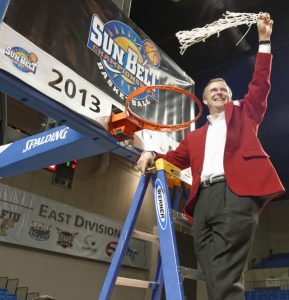
At the time Western’s president, Gary Ransdell stands atop a ladder and waves a basketball hoop net following WKU’s victory at the 2013 Sun Belt Conference basketball tournament in Hot Springs, Arkansas. (Gary Ransdell.)
The creation of The Gatton Academy, he said, was a game-changer.
“From that point on, Kentucky’s best high school juniors and seniors were enrolled on our campus at WKU, and that really caused people in the academic world to view us a bit differently,” Ransdell said.
Meanwhile, WKU built the Honors College with the aim of creating a top-10 liberal arts college on a public university campus.
“We achieved that,” he said. “I wanted to get to about 1,200 students, about the same size as a nice, small private liberal arts college. And I wanted our academic measures and the performance of those students to rival the best small private liberal arts colleges in America – and in large measure, we were able to do that.”
Obtaining permission for Western to offer advanced practice doctorates was another standout accomplishment, Lee said. WKU received the approval from the Council on Postsecondary Education in 2008 after longtime resistance from the legislature and state policymakers, Lee added.
“Historically, it has been a struggle for us to – first, back in the ’30s – begin to offer any graduate education at all, and there’s been strong resistance, really ever since then, to the comprehensive institutions like WKU and Eastern and Morehead offering doctoral-level work,” Lee said.
Offering practice doctorates in education and certain health fields “significantly expanded WKU’s capacity to serve the wider community,” he added.
Internationalization was another big focus for Ransdell.
Intending to provide a higher education for Saudis, the King Abdullah scholarship funded a WKU education for certain countries; effectively, it enabled WKU’s Saudi population to reach close to 500 students, Ransdell said.
Also, the Department of Defense’s Critical Languages Program offered federal funds as an incentive for universities to teach certain languages – and WKU opted to focus on Arabic and Chinese, later also becoming one of the nation’s more than 100 universities with a Confucius Institute, which enabled it to receive considerable funding at the time, Ransdell said.
“It wasn’t a tagline. It wasn’t the PR statement,” Ransdell said of the vision statement. “That was my intent, that was my drive, that was my complete pursuit … I did not want to say or see the word ‘regional’ anywhere in our vocabulary.”
Reflecting on his time at Western, Ransdell added that as far as he’s concerned, “there is no other university.”
“WKU is my life, my passion,” he said. “Both (my wife) Julie and me – and we gave everything we had for 20 years to achieve a bold vision for WKU.”
Present
Approaching eight years as president, Caboni has – among numerous other projects, and his navigation of the COVID-19 pandemic – upheld a focus on fundraising, improvements to academic quality and retention, the enrollment of students throughout the region into Nashville, and an aim to attain the Carnegie-classified “Research 2” status for Western.
“My job, I think, is to continue all the great things,” he said after detailing Ransdell’s accomplishments – “focusing on students and student success.”
The Opportunity Fund, which after six years surpassed its $100 million goal, established 267 new endowed scholarships at around the start of fall and provided private scholarship support for 20,205 students, Caboni has said.
Meanwhile, the university has improved retention from 70% to about 80% for first-year students, Caboni said.
This is, he added, an “extreme focus” for him. A new change under his tenure requires students to have a 2.0 to enroll – and if it’s a 2.5 or under, the university allows entry under the condition they work through the Summer Scholars Program. He has also presided over a great expansion of WKU’s Living Learning Communities – where students with similar academic or social interests live across a residence hall floor together.
“If you think about what we’ve done over the past seven years and what we’ve created – the Summer Scholars Program, ISEC Academy, the work we’ve done around scholarships, centralized advising – what we’re doing is shaping a first year class that has a much higher likelihood of graduating,” Caboni previously told the Daily News.
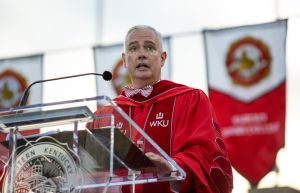
Western Kentucky University President Dr. Timothy Caboni speaks to around 3,000 graduating students and their friends and family members during the 2024 Commencement ceremony in Houchens Industries-L.T. Smith Stadium on Thursday, May 2, 2024. (GRACE MCDOWELL / Daily News)
Due to tightened funds within the King Abdullah Scholarship and a decreasing population of international students, Caboni has also seen an opportunity to return to its 27-county service region while penetrating more deeply into the Nashville market – which is now where more than a third of students are from, he said.
Caboni has also overseen the transformation of WKU’s Helm Library into a multipurpose facility comprising three floors of meeting space, locations for restaurants, closed study rooms, computer labs and classrooms.
“We’ve gotten tremendous national recognition for what is a library of the future: They’re no longer book repositories – they’re places where communities come together and folks work together,” Caboni said.
At the moment, at least three larger projects near completion: Honors 2.0, an expansion of the honors program, reportedly will be ready by the semester’s end; the 113,000-square-foot Gordon Ford College of Business is slated to open for fall; and the 120,000-square-foot Hilltopper Fieldhouse – to house e-sports programs and WKU Forensics while providing space for Hilltopper Athletics and the Big Red Marching Band – is slated for completion late this year.
Another vision – for the future
Achieving “R2” status is a top priority for Caboni – one that he believes will transform the university and its impacts regionwide.
To achieve it, a university must spend at least $5 million on research and development and produce a minimum of 20 research doctorates, according to the Carnegie Classification of Institutions of Higher Education.
Meeting those requirements will change WKU as an institution – from the kind of faculty it can attract, to the companies it can partner with, to the research funding it can pursue, to its ability to serve as a hub for innovation and creativity, Caboni has said.
But, while Western has more than doubled the research spending requirement, it’s still in the process of obtaining permission to offer research doctorates.
Ransdell commended the university’s efforts to do so. He added that it would mark a natural evolution and growth for the university – “elevating our status as an institution.”
Caboni reflected on the incorporation of the Kentucky Transpark in 1998 – which he described as a transformational idea that allowed for 20 years of manufacturing growth regionwide.
“We have to figure out what comes next,” he said. “For me, Innovation Campus, growing research, and ‘R2’ status is about transforming our economy as a region in partnership with the (chamber of commerce), the city, the county, and our economic development organizations, and with state investment …
For us to be successful, we’re gonna have to diversify our regional economy.”
“R2” status and raised research expenditures, he said, will attract entrepreneurial talent in Nashville and locally — in turn, benefiting Bowling Green and the regional economy.
He spoke of his own vision: a time when Western achieves “R2” status; when the university acquires more than $25 million in federally sponsored research; when total research expenditures reach $50 million; when companies are co-located and co-researching with Western; when Western is pushing those companies to grow and “spin out into the region.”
“All of a sudden, that also helps to transform our regional economy and Bowling Green and the region itself,” Caboni said.
“That story is to be written.”




